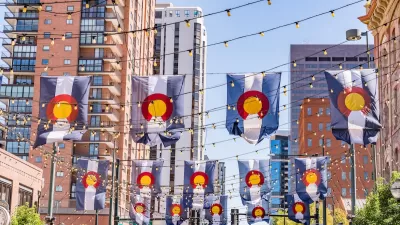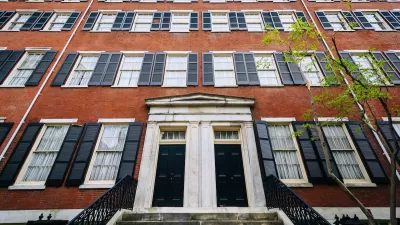Heretofore preservationists in the City of Brotherly Love have been focused on finding new uses for vacant, historic buildings, but the city's economic resurgence now threatens five, occupied low-rise buildings city's in vibrant Jewelers Row.
Philadelphia is rebounding after decades of decline. A high-end urban developer wants to capitalize on the city's revitalization to the chagrin of some jewelers who stand to lose their businesses so the district may prosper more.
"A plan by Toll Brothers City Living, a developer, to make way for 80 new residential units on the 700 block of Sansom Street, the center of Jewelers Row, is challenging some of the district’s businesses and is shifting priorities for activists in the city," writes Jon Hurdle for The New York Times.
Toll Brothers plans to demolish five three- and four-story buildings erected in the late 19th and early 20th centuries to build a 16-story condominium tower. It has promised to preserve the appearance of the street by building a new facade on the site of the demolished buildings. Demolition is scheduled to start in mid-2017, and construction is expected to take about two years.
"The project is another signal of soaring demand for residential and commercial retail space in a city that had decades of economic decline after a manufacturing slump, starting in the mid-20th century, but which is now seeing a renaissance in its central area," adds Hurdle.
"For most of the last half century, we were fighting the forces of depopulation and decline, and so preservation was often about finding new uses for vacant buildings before we lost them," said Paul Steinke, executive director of the Preservation Alliance for Greater Philadelphia,
Like most older, large cities in America, Philadelphia's population peaked after World War II and then declined until relatively recently.
Year Population Percentage Change from Prior Decade
1950 2,071,605 +7.3%
1960 2,002,512 −3.3%
1970 1,948,609 −2.7%
1980 1,688,210 −13.4%
1990 1,585,577 −6.1%
2000 1,517,550 −4.3%
2010 1,526,006 +0.6%
2014 1,560,297 +2.2%
Credit: Demographics of Philadelphia - Wikipedia.
“Jewelers Row is symbolic of a new reality, which is that occupied, functioning, taxpaying buildings with businesses and residences already in them for a century or more are now being targeted for developers for demolition and new construction,” Steinke said.
Hurdle interviews some of the jewelers who stand to be displaced by the development. For them, location is key, and many suspect they will lose their livelihood if forced to vacate from their buildings.
One term not found in the article is gentrification, although that it is used in an earlier post on the project by Planetizen contributing editor Philip Rojc.
“The Jewelers Row situation is definitely a wake-up call that our preservation, planning and zoning apparatus is out of sync with contemporary needs in a historic city that’s undergoing a building boom,” Mr. Steinke said
"The city’s zoning board last week declined an appeal against the development by the Preservation Alliance," adds Hurdle.
Related on Planetizen:
- Preservation in Philly Is Attracting a Younger Generation, October 21, 2015
-
Luxury Condos Versus Philadelphia's Jewelers' Row, April 14, 2015
Correspondent's footnote: 'Save Jewelers Row' T–shirt can be purchased from Preservation Alliance.
FULL STORY: In Jewelers Row in Philadelphia, Condo Plan Worries Preservationists

Alabama: Trump Terminates Settlements for Black Communities Harmed By Raw Sewage
Trump deemed the landmark civil rights agreement “illegal DEI and environmental justice policy.”

Planetizen Federal Action Tracker
A weekly monitor of how Trump’s orders and actions are impacting planners and planning in America.

Why Should We Subsidize Public Transportation?
Many public transit agencies face financial stress due to rising costs, declining fare revenue, and declining subsidies. Transit advocates must provide a strong business case for increasing public transit funding.

Understanding Road Diets
An explainer from Momentum highlights the advantages of reducing vehicle lanes in favor of more bike, transit, and pedestrian infrastructure.

New California Law Regulates Warehouse Pollution
A new law tightens building and emissions regulations for large distribution warehouses to mitigate air pollution and traffic in surrounding communities.

Phoenix Announces Opening Date for Light Rail Extension
The South Central extension will connect South Phoenix to downtown and other major hubs starting on June 7.
Urban Design for Planners 1: Software Tools
This six-course series explores essential urban design concepts using open source software and equips planners with the tools they need to participate fully in the urban design process.
Planning for Universal Design
Learn the tools for implementing Universal Design in planning regulations.
Caltrans
Smith Gee Studio
Institute for Housing and Urban Development Studies (IHS)
City of Grandview
Harvard GSD Executive Education
Toledo-Lucas County Plan Commissions
Salt Lake City
NYU Wagner Graduate School of Public Service





























